Classicism and French mantel clocks

This article is based on a lecture that was held in our shop on May 20th and 21st 2017.
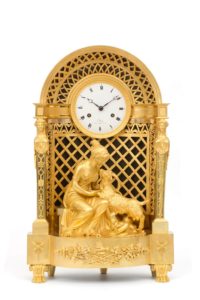 The reason for choosing this subject was a discussion that we had after buying this fine French mantel clock. The casting, chiseling and gilding is of excellent quality and it must have been expensive at the time it was made. But the subject matter can be called unusual. When we take a closer look we see a classical lady next to a goat feeding a baby. The question might arise; who would like to have this scene on his mantel piece? And Why? Actually when thinking about it, it is also remarkable that the art of the Classical Antiquity was chosen as example and subject for the art of the late Middle Ages and after. Often classical art has nude figures in it. Their civilization was pagan and they had many Gods. Furthermore a large number of esteemed philosophers and a number of emperors were homosexual, which was problematic for Christian society. And finally, Western society deemed themselves superior to other civilizations because according to them the others didn’t have the right faith and therefore just were barbarians. For example, they looked down on the Arabic world that was actually much further in science and art in that time.
The reason for choosing this subject was a discussion that we had after buying this fine French mantel clock. The casting, chiseling and gilding is of excellent quality and it must have been expensive at the time it was made. But the subject matter can be called unusual. When we take a closer look we see a classical lady next to a goat feeding a baby. The question might arise; who would like to have this scene on his mantel piece? And Why? Actually when thinking about it, it is also remarkable that the art of the Classical Antiquity was chosen as example and subject for the art of the late Middle Ages and after. Often classical art has nude figures in it. Their civilization was pagan and they had many Gods. Furthermore a large number of esteemed philosophers and a number of emperors were homosexual, which was problematic for Christian society. And finally, Western society deemed themselves superior to other civilizations because according to them the others didn’t have the right faith and therefore just were barbarians. For example, they looked down on the Arabic world that was actually much further in science and art in that time.
But it was impossible to deny the accomplishments of antique society. There were still enough buildings, ruins and sculptures left to show that their art was superior to Western art. Sporadic survived books showed that science, philosophy and literature had been at a very high level.
The term Classicism is used for art that is inspired or based on the art of the antiquity (Greeks and Romans). In a narrow sense the term Neo Classicism is used for the period of Louis XVI going through to the end of the Empire. A lot of the art that was made in this period was inspired on Antiquity.
But in a broad sense Antiquity was already an inspiration or example for much longer. For instance Romanesque architecture (10th – 12th C) is clearly inspired on Roman architecture.
During the Baroque era classical elements and shapes were used to create a new art.
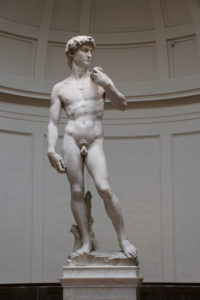 But the most obvious period in which Classical art was admired was the Renaissance. ‘Renaissance’ means ‘rebirth’, which refers to the rebirth of Classical art. In the second half of the 15th C there were philosophers and artists that used classical philosophy to justify their admiration and adaptation of classical examples.
But the most obvious period in which Classical art was admired was the Renaissance. ‘Renaissance’ means ‘rebirth’, which refers to the rebirth of Classical art. In the second half of the 15th C there were philosophers and artists that used classical philosophy to justify their admiration and adaptation of classical examples.
An important event in this development is the conquering of Constantinopel ( current Istanbul), the ancient capital of the Eastern Roman Empire in 1453 by the Ottomans. Many fled the city among which scholars who brought classical books yet unknown in the west.
Neoplatonism
As the word implies, Neo Platonism is based on the works of Plato. It was the philosopher Plotinus (3rd C AD) played an important role in the development of this philosophical school.
Neoplatonism isn’t an all comprehensive system but more a collection of ideas which are used to explain a number of problems.
An important view is that there is a supernatural invisible world in which the Gods and ideas are. Opposite to this world is a visible tangible world that is subject to change in which we live. There is a clear contradiction between the spiritual/intellectual and the physical/instinctive.
Neoplatonists see the divine or elevated in everything in more or lesser measure. A rock for instance, stands very low. Above this there is for instance a plant, above which there is an animal. Above all is mankind. We humans have a key position between the higher invisible world and the lower visible world. This because the human soul can choose to either elevate itself, or to attach itself to the worldly material.
One can elevate himself by contemplation (deep thought or praying). But also by listening to beautiful music, poetry or looking at something beautiful and elevated. This idea still lives in our society. My mother always told me that it was better to read a book than looking at the television. There are still people that speak of elevating the masses. They would do that by going to the theater, the museum or opera. It would turn the masses into better people.
I do understand a little bit why the Neoplatonists thought that one could get close to the elevated world or God by for instance listening to beautiful music. Sometimes music can touch your emotions that it is almost tangible. Or when someone feels that everything just falls into place and for a short moment thinks he understands everything.
When everything is more or less divine, what is the most divine shape or form? It is man. Because man was created in the image of God. This explains the depiction of naked (idealized) figures but also justifies it. It actually elevates you when looking at them. Mankind is therefore not only the connection between the higher and lower world because of the human soul. But mankind is also the pinnacle of beauty.
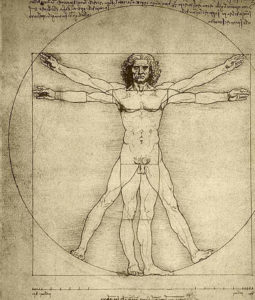 This famous drawing of Leonardo da Vinci shows that man fits perfectly in a circle and square. How far Neoplatonist thinking went with art is illustrated by the one of the big differences between Gothic and Renaissance architecture. In Gothic architecture plans and forms are based on rectangles, hexagonals and triangles. Reniassance architecture instead is based on squares and circles because these shapes were regarded as more divine with their relation to the human body.
This famous drawing of Leonardo da Vinci shows that man fits perfectly in a circle and square. How far Neoplatonist thinking went with art is illustrated by the one of the big differences between Gothic and Renaissance architecture. In Gothic architecture plans and forms are based on rectangles, hexagonals and triangles. Reniassance architecture instead is based on squares and circles because these shapes were regarded as more divine with their relation to the human body.
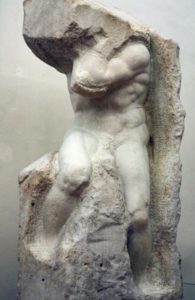 Michelangelo also was a very strong supporter of Neoplatonism and worked very literally to the ideas. He once stated that the divine form was already in the rock, all he had to do was to take away the excess stone. This working method is apparent when we look at an unfinished sculpture of his. He stopped working on it because he thought that he made a mistake and it wasn’t possible anymore to get to the divine form. A pupil of Michelangelo described his way of working like water was running from the tub and the body became visible. He worked straight from the rough stone to great detail.
Michelangelo also was a very strong supporter of Neoplatonism and worked very literally to the ideas. He once stated that the divine form was already in the rock, all he had to do was to take away the excess stone. This working method is apparent when we look at an unfinished sculpture of his. He stopped working on it because he thought that he made a mistake and it wasn’t possible anymore to get to the divine form. A pupil of Michelangelo described his way of working like water was running from the tub and the body became visible. He worked straight from the rough stone to great detail.
Platonic love is also based on Neoplatonism. Platonic love is not the physical but the spiritual not physical love. It was regarded as much more noble and superior to physical love.
With the acceptance and assimilation of Classical art and forms, an art evolved in which abstract ideas could be represented by figures from mythology or another personification. For example Cupid is not just a naked boy with wings but he represents ‘love’. Urania the muse of astronomy is often depicted as the personification of science.
With this array of classical forms, symbols and personifications, artists could put a message or theme in their creation that was demanded for by the patrons. They could install important values and themes in their art.
But the ‘composing’ of art by the classical examples, personifications and prescribed themes a little artificial. This is one of the things that the innovating artists of the 19th C moved against.
It is quite normal for a social group to distinguish themselves through fashion, art and music etc. The elite of France in the second half of the 18th Century embraced classical art. They liked to mirror themselves to antiquity with its high standard of science, art and architecture. Their values and ideas also were based on the Neoplatonists ideas, in which intellect was placed above instinct. With this they placed themselves above other social classes and could justify their higher position.
To be able to mix in the high social class of the 18th Century one needed have knowledge of politics, philosophy, music and art. Many of the rich families send their sons on a ‘Grand Tour’ through Europe to visit the important cultural places and thus collecting enough cultural luggage to uphold themselves socially.
As stated before the art of the elite wasn’t just made to be beautiful, it also incorporated their beliefs and values. Through the ‘message’ in the art it showed what this elite stood for. But it also gave the owner to show his knowledge and erudition.
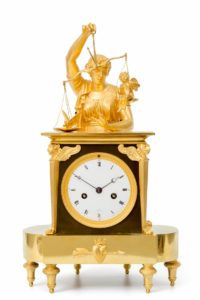 A nice example of such a ‘message’ in an object d’art is shown in this French mantel clock in our collection. It shows a seated classical lady with a scale which is often wrongly referred to by people seeing it as ‘Lady Justice’. Because if we look more closely we see on the scale on the one side Cupid, and on the other side a butterfly. Before I stated that Cupid is the personification of love. But there is a nuance to that, it is the personification of earthly, physical love, passion and falling in love. The butterfly symbolizes a higher, spiritual love which is also referred to as ‘Phyche’. In Neoplatonical terms; Cupid refers to the visible lower world, while the butterfly refers to the higher invisible world. Cupid should weigh more than a mere butterfly, but not in this theme. It shows that the spiritual Platonic love is regarded higher than the physical earthly love. In this way, the mantel clock shows what values were important to the owner.
A nice example of such a ‘message’ in an object d’art is shown in this French mantel clock in our collection. It shows a seated classical lady with a scale which is often wrongly referred to by people seeing it as ‘Lady Justice’. Because if we look more closely we see on the scale on the one side Cupid, and on the other side a butterfly. Before I stated that Cupid is the personification of love. But there is a nuance to that, it is the personification of earthly, physical love, passion and falling in love. The butterfly symbolizes a higher, spiritual love which is also referred to as ‘Phyche’. In Neoplatonical terms; Cupid refers to the visible lower world, while the butterfly refers to the higher invisible world. Cupid should weigh more than a mere butterfly, but not in this theme. It shows that the spiritual Platonic love is regarded higher than the physical earthly love. In this way, the mantel clock shows what values were important to the owner.
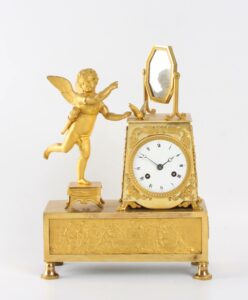 The next mantel clock also shows what was important for the owner and his or her values. We see a standing Cupid on a stool in front and pointing at a mirror. We know now that Cupid symbolizes the physical love. The mirror refers to conceit, vein and outer appearance. Both the mirror and Cupid symbolize values not very appreciated by the French elite. Which becomes clear when we look more closely. There is a butterfly sitting between Cupid and the mirror. It is Psyche (reason) that stands between the two bad personifications. It is reason that keeps us away from the earthly bad characteristics. Furthermore on the base there is a relief which shows us Cupids that are practice shooting at a heart. This implies a warning; be careful Cupid is always practicing and could strike at any moment, hitting you with an arrow. When that would happen, it would cause all kind of problems of course. It would conflict possibly with marriage and steer that person away from the higher spiritual world, to the lower physical world.
The next mantel clock also shows what was important for the owner and his or her values. We see a standing Cupid on a stool in front and pointing at a mirror. We know now that Cupid symbolizes the physical love. The mirror refers to conceit, vein and outer appearance. Both the mirror and Cupid symbolize values not very appreciated by the French elite. Which becomes clear when we look more closely. There is a butterfly sitting between Cupid and the mirror. It is Psyche (reason) that stands between the two bad personifications. It is reason that keeps us away from the earthly bad characteristics. Furthermore on the base there is a relief which shows us Cupids that are practice shooting at a heart. This implies a warning; be careful Cupid is always practicing and could strike at any moment, hitting you with an arrow. When that would happen, it would cause all kind of problems of course. It would conflict possibly with marriage and steer that person away from the higher spiritual world, to the lower physical world.
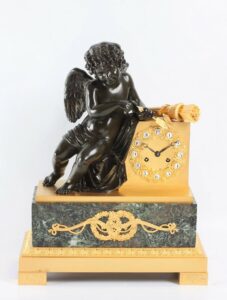 Looking at this next clock as a 21st Century person, we see a beautiful mantel clock surmounted by a well cast and chiseled sculpture of Cupid. He is holding an arrow and he is feeling if the point is sharp and smiling. On the base of the clock there are two intertwining wreaths of laurels over a broken bow.
Looking at this next clock as a 21st Century person, we see a beautiful mantel clock surmounted by a well cast and chiseled sculpture of Cupid. He is holding an arrow and he is feeling if the point is sharp and smiling. On the base of the clock there are two intertwining wreaths of laurels over a broken bow.
But to my idea and an 18th Century person this clock might well personify ‘marital loyalty’. It says; ‘be careful, Cupid has sharp arrows and is lurking’. The two wreaths represent the married couple. With the wreath laying over the broken bow, they defeat the threats of Cupid.
 Now we have returned to the mantel clock which started this story. Many of the French 18th Century elite knew something of Greek Mythology. They well might have known that the figures here are the infant Zeus and the goat Amalthea. Zeus was the child of Cronos and Rhea. Cronos had been told that one of his children would cause his downfall. Because of this he would eat his new born children. To avoid this Rhea fled during her pregnancy to Crete, to give birth to Zeus in a cave between animals. When Cronos found her and wanted to eat his new sibling, she tricked him by giving him a stone wrapped in cloth making him think it was his child. Zeus remained in the cave. One version of the story states that there was a nymph called Amalthea feeding him with the milk of a goat. In another version, the goat is called Amalthea. Later Zeus would break off one of Amalthea’s horns while playing, which would turn into the Cornucopia, the horn of plenty. In another story Zeus kills Amalthea and uses her skin to make his magical shield ‘The Aegis’, and her horn to make the Cornucopia. Being very grateful for her milk he places her among the stars in the constellation Capra. Other versions speak of the constellation Capricorn.
Now we have returned to the mantel clock which started this story. Many of the French 18th Century elite knew something of Greek Mythology. They well might have known that the figures here are the infant Zeus and the goat Amalthea. Zeus was the child of Cronos and Rhea. Cronos had been told that one of his children would cause his downfall. Because of this he would eat his new born children. To avoid this Rhea fled during her pregnancy to Crete, to give birth to Zeus in a cave between animals. When Cronos found her and wanted to eat his new sibling, she tricked him by giving him a stone wrapped in cloth making him think it was his child. Zeus remained in the cave. One version of the story states that there was a nymph called Amalthea feeding him with the milk of a goat. In another version, the goat is called Amalthea. Later Zeus would break off one of Amalthea’s horns while playing, which would turn into the Cornucopia, the horn of plenty. In another story Zeus kills Amalthea and uses her skin to make his magical shield ‘The Aegis’, and her horn to make the Cornucopia. Being very grateful for her milk he places her among the stars in the constellation Capra. Other versions speak of the constellation Capricorn.
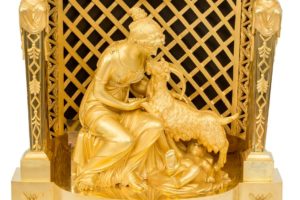 There are a number of parallels between the infancy of Jezus and infancy of Zeus. Jezus was also born in a cave or stable between animals. Jezus was chased by Herodes, Zeus was chased by Cronos and both had to flee. Zeus would become the most important God of all Greek Gods, ruler of heaven and earth. (Poseidon was God of the sea, Hades was God of the underworld.) A connection can be made with Amalthea because she was put in Capricorn, the constellation under which Jezus was born.
There are a number of parallels between the infancy of Jezus and infancy of Zeus. Jezus was also born in a cave or stable between animals. Jezus was chased by Herodes, Zeus was chased by Cronos and both had to flee. Zeus would become the most important God of all Greek Gods, ruler of heaven and earth. (Poseidon was God of the sea, Hades was God of the underworld.) A connection can be made with Amalthea because she was put in Capricorn, the constellation under which Jezus was born.
It is wrong to believe that 18th Century people thought that Zeus and Jezus were the one and the same figure. It is more sort of a pre-announcement. Don’t forget that in the 18th Century it was believed that the world was about 5000 years old according to the Bible. this implied that the stories of Greek Mythology originated close to the beginning of the world, possibly partly from God directly. Was it not so that God had spoken to Mozes and had given him the Ten Commandments? Many stories from the Old Testament are seen as pre-announcements for events in the New Testament. In this case the story of the infancy of Zeus strengthens the importance and status of Jezus.
We therefore are not just looking at a lady with a goat and a baby. We are actually looking at a sort of pagan Christmas stall, that magnifies and strengthens the status of Jezus through a story from Greek Mythology.

